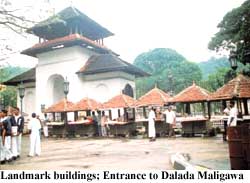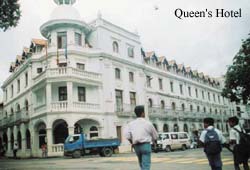 |
 13th June 1999 |
Front Page| |
 Kandy conserved |
Contents
|
|
 |
Kandy conservedBy Hiranthi Fernando
The UDA Chairman last month notified owners and occupants of the chosen buildings that under UDA law, any alterations, additions and/or repairs to these buildings, require the prior approval of the UDA/Kandy Municipal Council. The buildings cannot be demolished. Ms. Janaki Hettiarachchi, of the Kandy UDA, says that a plaque is being prepared to be fixed to the conserved buildings so that the owners could be proud of their buildings. Robert Knox, describing the Kandyan Kingdom in 1681 wrote, ...."within this wall it is all full of houses, most of which are low and thatched; but some are two stories high, and tiled very handsomely, with open galleries for air, railed about with turned banisters, one ebony and one painted.....". "The main quality of the city is its humble nature, which has been evident throughout the history of Kandy. The principal aim of the World Heritage concept is to maintain this character. Within this, we will allow two or three floors to be built," said Ms. Champika Hettiarachchi, architect attached to the Central Provincial Council. "When identifying the buildings, we looked for the low scale and the period of architecture, kings', British or post British periods. It did not matter if the building was very fragile and shabby." The identification of the buildings was carried out by the UDA, the Central Cultural Fund and the Central Provincial Council, on behalf of the Kandy Municipal Council. The UDA as the controlling authority in the project, has delegated powers to the Municipal Council of Kandy. Ms. Sujeewa Deraniyagala of the Central Cultural Fund explained that UNESCO had identified Kandy as a World Heritage City, with the Dalada Maligawa as the hub and the city as a buffer zone. The buildings situated along major streets in the city grid, were classified into three categories. The first category of buildings are those to be conserved where nothing could be changed.
In the second category of buildings, alterations or improvements are possible provided that the original facade remains unchanged. For the development of such buildings, the UDA will provide assistance in designs and architectural drawings. The DFCC Building at Deva Veediya is a good example of a renovation carried out to meet the aspirations of the World Heritage authorities. The third category comprises buildings which are an eyesore and should eventually be demolished, although this cannot be achieved in a hurry.
Ms. Champika Hettiarachchi explained that in a survey conducted in 1986, 807 buildings were classified into four groups. There were 44 buildings of Period 1, (before 1850), 166 of Period 2 (1850 - 1900), 320 of Period 3 (1900 - 1950), and 277 of Period 4 (1950 - 1986). However, between 1986 and 1998, many of these buildings have been demolished and subdivided. Some old houses are being sold for business premises. The current list of 325 buildings has been prepared on a first screening. More work is being done on this. "It is not intended to sterilize the city or stop its development," stressed Ms. Hettiarachchi. A maximum height of 40 feet with three floors are permitted. The Vanik Building at D.S. Senanayake Veediya, for instance, has been developed, adding a second floor, while retaining its character. Conserved buildings were also given a concession whereby they did not have to keep 50 feet from the centre of the road as was mandatory for other structures. The Swarnamahal Building at the corner of Yatinuwara Veediya and Dalada Veediya has also been improved keeping to the requirements. New constructions in the city also need approval from the UDA. The Bank of Ceylon has constructed a new building which conforms in design to the requirements, although to a lay person, the exterior walls of polished granite seem to clash with the older buildings in the vicinity. Kandy Mayor Harindranath Dunuwille says when a circular was first sent out at the beginning of the Heritage concept in 1994/95, the people of Kandy were very responsive. The process dragged on, the list was prepared last June and the letter sent out to the owners last month. Now, some of the owners of conserved buildings are apprehensive. The value of a building diminishes in a high commercial centre, when it cannot be altered at the will of the owner. Those who wished to divide a property between their children have faced difficulties. "In some countries where they have done this, Norway for example, facilities such as tax concessions have been granted to the owners of conserved buildings to compensate for any loss," the Mayor said. The Mayor says they plan to reintroduce the old street names that existed in the era of the Kandyan kings. These were changed during the British period and once again in the post Independence years. For example, D.S. Senanayake Veediya was known as Trincomalee Street during British times. During the Kandyan kings' period, this street was made up of three streets, Borawe Veediya, Nagaha Veediya and Hetti Veediya. Dalada Veediya bore the same name during the Kandyan period but was changed to Ward Street by the British. UDA Chairman Prof. Nimal de Silva explained that in identifying buildings to be conserved, the age of the structures, their architectural character, architectural detailing, historical significance and the composition of the street are factors that have been taken into consideration. Kandy is one of six World Heritage sites identified by UNESCO in Sri Lanka, on the basis of cultural heritage. The others are the historic cities of Anuradhapura and Polonnaruwa, the water gardens of Sigiriya, painted caves of Dambulla, and the Dutch fortress of Galle. The Sinharaja rain forest has been identified as a natural heritage site.
Front Page| News/Comment| Editorial/Opinion| Business| Sports | Mirror Magazine |
|
 |
Please send your comments and suggestions on this web site to |
|
 A
historic building such as the Queen's Hotel has to preserve its original
facade. Inside the building, only reversible changes that do not alter
the original features of the building are permitted. Ms. Deraniyagala cited
an instance where an owner of a building in Colombo Street had wanted to
replace the old timber floor with a concrete slab. Such changes are not
allowed since they are irreversible and alter the original character of
the building. Buildings over 100 years are classified as archaeological
monuments. There are 25 such buildings in Kandy.
A
historic building such as the Queen's Hotel has to preserve its original
facade. Inside the building, only reversible changes that do not alter
the original features of the building are permitted. Ms. Deraniyagala cited
an instance where an owner of a building in Colombo Street had wanted to
replace the old timber floor with a concrete slab. Such changes are not
allowed since they are irreversible and alter the original character of
the building. Buildings over 100 years are classified as archaeological
monuments. There are 25 such buildings in Kandy. The
Temple Street, Deva Veediya area, retains an old world charm, with many
buildings ear-marked for conservation such as the Olde Empire Hotel, the
Muladeniya Mandiriya, now used as the Tourist Information Centre, the row
of lawyers' offices and the Central Cultural Fund publication office which
was probably an old court house. At the junction of these two streets is
a quaint old fountain erected by the Coffee Planters of Ceylon to commemorate
the visit of HRH Prince of Wales to Kandy in 1875. At Kumara Veediya, can
be seen many small old buildings typical of the old city, juxtaposed with
modern glass fronted buildings
The
Temple Street, Deva Veediya area, retains an old world charm, with many
buildings ear-marked for conservation such as the Olde Empire Hotel, the
Muladeniya Mandiriya, now used as the Tourist Information Centre, the row
of lawyers' offices and the Central Cultural Fund publication office which
was probably an old court house. At the junction of these two streets is
a quaint old fountain erected by the Coffee Planters of Ceylon to commemorate
the visit of HRH Prince of Wales to Kandy in 1875. At Kumara Veediya, can
be seen many small old buildings typical of the old city, juxtaposed with
modern glass fronted buildings